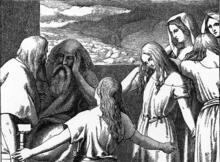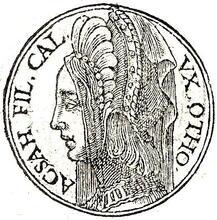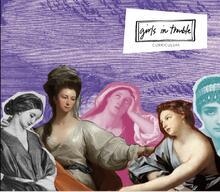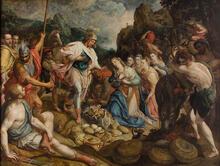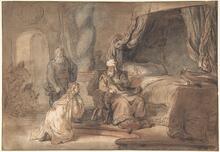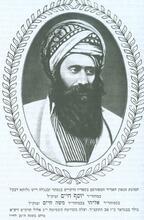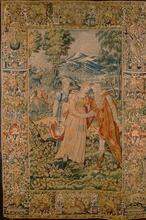Daughters of Zelophehad: Bible
According to God’s original decree, the promised land was to be apportioned according to the “number of names” of members of the second generation; since only men were counted in the census, Zelophehad’s five daughters would be left without an inheritance. When they appeal this regulation, God agrees to implement their proposal. The story of the five daughters of Zelophehad provides legitimation of a limited right of Israelite women to inherit land. It also places specific marriage restrictions upon any women who inherit under this right. The story celebrates women’s boldness and at the same time offers comfort for men who have the misfortune (from the Bible’s androcentric point of view) to have no sons.
Article
The story of the five daughters of Zelophehad provides legitimation of a limited right of Israelite women to inherit land. It also places specific marriage restrictions upon any women who inherit under this right. The story celebrates women’s boldness and at the same time offers comfort for men who have the misfortune (from the Bible’s androcentric point of view) to have no sons.
Zelophehad has five daughters, Mahlah, Noah, Hoglah, Milcah, and Tirzah; he has no sons. Zelophehad is part of the generation of Israelites who departed from Egypt under Moses’ leadership and died during the forty years in the wilderness. His five daughters belong to the new generation that would enter and possess the promised land. (Their mother is never mentioned.)
According to God’s decree, the promised land is to be apportioned according to the “number of names” of members of the second generation counted in the census recorded in Numbers 26 (see 26:5z-56). Since only men were counted in the census, however, Zelophehad’s daughters would be left without an inheritance.
Mahlah, Noah, Hoglah, Milcah, and Tirzah come forward to appeal this regulation, stating their case in front of the sacred tent of meeting in the presence of Moses, Eleazar the priest, the leaders, and indeed the whole community (Num 27:2). They argue that their father’s name (lineage) should not be cut off from his clan just because he had no son and that they should be permitted to inherit his land portion (v. 4) in order to avoid this potential injustice to their father’s name (and property). The story presumes a culture that recognizes a connection between landholding and preservation of a male name in a family lineage.
Moses consults God, and God announces the decision to Moses: the proposal of the daughters of Zelophehad is to be implemented (vv. 5–7, Joshua ). The text then moves beyond the particular case to report God’s further generalized regulation for order of inheritance: when there are no sons, daughters shall have first inheritance rights, followed by other male relatives in a set sequence (vv. 8–11). This agreement is similar to the story of Achsah, who asks for and receives some of her family’s land and water resources (1 Chron. 2:49, Joshua 15:16-19, Judges 1:9-15).
Later on, the male relatives of the Manassite clan to which Zelophehad belonged recognize what to them appears to be a large loophole in this ruling. Their appeal to Moses is recorded in Numbers 36.
The male relatives point out that when the daughters of Zelophehad get married, the land that they have inherited will go with them to the clans of their husbands. (The possibility that a man might change clans in such a case was presumably beyond Israel’s imagining.) The relatives are concerned that the marriage of any of the daughters outside their own tribe will lead to diminution of the Manassite landholdings. Moses announces that God does not intend any moving of land from tribe to tribe. As insurance against such movement, the daughters of Zelophehad (and any other daughters who inherit land) must marry within the clan of their father’s tribe.
The daughters do marry within their clan (Num 36:10–12) and eventually receive their inheritance (Josh 17:3–6).
Ben-Barak, Zafrira. Inheritance by Daughters in Israel and the Ancient Near East: a Social, Legal and Ideological Revolution. Jaffa: Archaeological Center Publications, 2006.
Gafney, Wilda C. Womanist Midrash: A Reintroduction to the Women of the Torah and the Throne. Louisville: Westminster, 2017.
Graham, M. Patrick “Mahlah.” Anchor Bible Dictionary, edited by David Noel Freedman, 4:475–76. New York: 1992.
Ilan, Tal. “The Daughters of Zelophehad and Women's Inheritance: The Biblical Injunction and Its Outcome.” In Exodus to Deuteronomy: a Feminist Companion to the Bible, edited by Athalya Brenner, 176-186. Sheffield: Sheffield Academic Press, 2000.
Meyers, Carol, General Editor. Women in Scripture. New York: 2000.
Russaw, Kimberly D. Daughters in the Hebrew Bible. London: Rowman & Littlefield, 2018.
Sakenfeld, Katharine Doob. “Feminist Biblical Interpretation.” Theology Today 46 (1989): 154–168.
Shemesh, Yael. “A Gender Perspective on the Daughters of Zelophehad : Bible, Talmudic Midrash, and Modern Feminist Midrash.” Biblical Interpretation 15:1 (2007), 80–109.


